Executive Summary
Housing affordability remains a top issue facing Coloradans. With rising inflation, supply chain disruptions, workforce shortages, and complex land-use regulations, the outlook for housing development in the state looks bleak. With such a laundry list of economic and regulatory hurdles, not all within its immediate control, the state should focus on policy interventions that have the best chance of breaking the status quo and improving affordability at scale. Housing policy in Colorado should focus on fostering an environment that enables more affordable, workforce, and market rate development. For example, the state has passed promising legislation like the Innovative Housing Incentive Program (HB22-1282) that supports innovative housing. However, other recently passed legislation such as Building Greenhouse Gas Emissions (HB22-1362), which requires the adoption of model energy codes, will create additional barriers to development that will make housing more expensive in Colorado.
HB22-1362 seeks to reduce reliance on natural gas in new residential and commercial buildings. It requires the adoption of stringent energy codes plus electric and solar-ready and green codes for new buildings and renovations. The energy code is one of several recent policies the state has passed to achieve its greenhouse gas emission (GHG) reduction targets in the building sector. With a goal to reduce statewide GHG pollution 26% by 2025, 50% by 2030, and 90% by 2050, electrifying new buildings will not be enough. To reach its goal, the state will have to address how it will reduce GHG emissions from existing homes and buildings, a costly undertaking for property owners.
A primary avenue for reducing the use of natural gas in residential and commercial buildings is full electrification. Full electrification in the built environment is an ambitious target no state has accomplished to date. The road to electrification is fraught with market and policy barriers that will prove costly to consumers if not implemented correctly. As technology continues to advance and the electricity grid becomes cleaner, electrification may indeed prove beneficial to the consumer. However, if the transition continues aggressively without affordability as a key consideration, Colorado will continue to make housing less affordable and further out of reach for many homebuyers and renters which will severely impact the state’s economy.
Before a full transition to electrification begins, policymakers and consumers must understand the complex tradeoffs they face before beneficial electrification will truly be beneficial for both the consumer and the environment.
Key Findings
- CSI estimates Colorado’s housing deficit at 195,912 units. Based on forecasted population growth and the current rate of growth in residential construction, CSI estimates the deficit could feasibly reach 514,462 units by 2031. High home prices, coupled with increasing interest rates will mean housing will remain unaffordable.
- Adopting a more stringent minimum energy code will increase the cost to build new homes. Analysis shows the additional costs range anywhere between $6,450 and $22,352 per new home.
- The recently enacted requirement for a minimum standard home building energy code paves the way to full electrification of buildings in Colorado, but there has been little work done to estimate the total cost of residential and commercial building electrification.
- Based on a study of the cost of residential electrification done by Black Hills Energy, the public utility for Rocky Ford, CO, the combined cost of ‘behind the meter’ expenses and electric utility infrastructure would range between $36K to $42K per existing unit, for a total statewide cost of $59.1B to $68.4B.
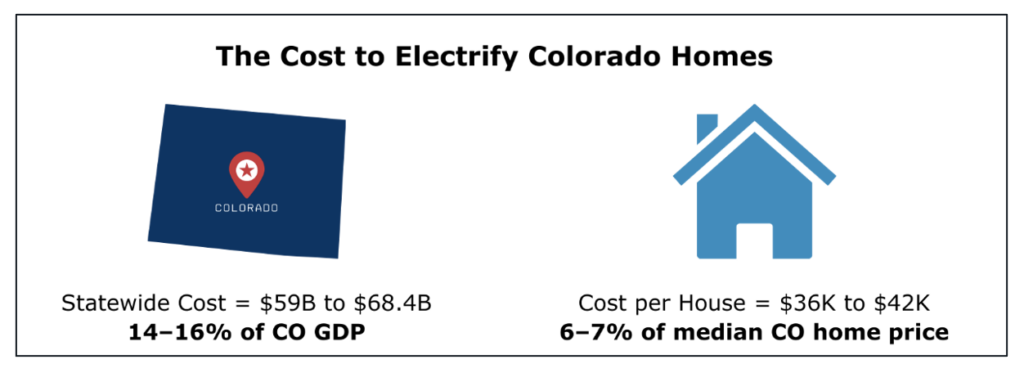
Before pursuing widespread electrification of buildings, policymakers should calculate the total costs and ensure the required infrastructure to support electrification will be available. This should ensure the costs and reliability impacts do not outweigh the benefits.
Recommendations:
- The Energy Code Board should ensure a transparent and fair stakeholder process for adoption of codes for Colorado and allow for public input.
- The Energy Code Board should adopt model codes that also prioritize affordability.
- Prior to embarking on full electrification, policymakers should fully understand the costs to consumers using a simple payback method.
The Housing Shortage in Colorado Continues
A shortage of housing remains a major issue for Colorado. Colorado has attracted an influx of people but has been underbuilding for years. To accommodate the growing population, Colorado needs to build more housing units across all price points but particularly in the entry-level market as millennials and younger generations enter the housing market.
Colorado population growth in the 2020 Census showed a 744,518 increase, or a 14.8%, increase over 2010 Census population. The total growth is comparable to the prior decade which saw a population increase of 727,935 which means Colorado has added 1.47M residents over the last two decades. Between 2010-2020, Colorado had the sixth highest growth percentage among U.S. states, behind only Utah, Idaho, Texas, North Dakota, and Nevada.[i]
The State Demographer’s forecast predicts population growth in Colorado will slow over the next few decades yet continue to outpace the rest of the nation. Between 2020 and 2030, the state’s population is projected to increase by 717,000 with 88% of that increase in the Front Range. The northern Front Range is expected to experience the fastest growth with an annual average growth of 151,000 people.
Housing development in Colorado has not kept up with population growth which contributes to the increase in housing prices throughout the state. The 2021 CSI Terry J. Stevinson Fellowship report showed that not only did the housing deficit originate during the Great Recession but has continued to grow since.
The Great Recession obliterated the housing development market. In the year 2008 we built 18,998 homes, a reduction of 35.5%, compared to 2007 when we built 29,454. But wait, it gets worse. When we compare 2008 to the average from 2000 to 2007 of 44,653 homes built per year, representing a reduction of 57.45%. Okay, so that’s concerning but wait again, the bleeding continues. In 2009, we built 9,355 units, representing a reduction of 79% ... from 2010 to 2014 we averaged 20,921 units created a year, a reduction of 53% from our pre–Great Recession average.[ii]
CSI estimates our current housing supply shortage to be 195,912 housing units. Under current conditions, the deficit is predicted to grow to 338,658 in 2026 and 514,462 in 2031. To close the deficit by 2026, 67,732 housing units will need to be built every year. To put that number into perspective, that is more units that we have ever built in Colorado in any one year; the highest being in 1972 with 65,664 units built.
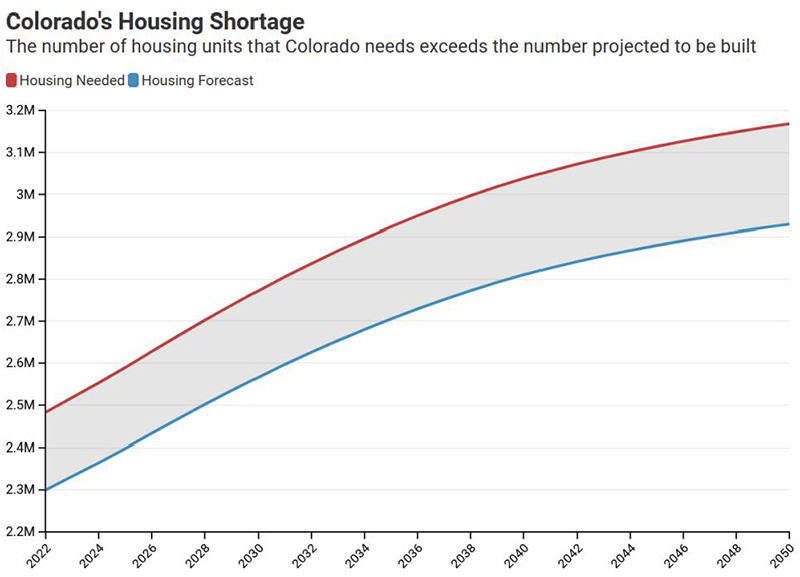
Even as mortgage and interest rates are increasing and the Federal Reserve tightens monetary policy and ends quantitative easing to lower inflation, the demand for housing is not expected to lessen in the coming years. In part, it is due to continued population growth and Millennials reaching first-time home buying age.
The shortage of homes is causing prices to escalate rapidly as demand for housing increases; a trend seen throughout Colorado as the median price of a home reached $600,000 in April according to the Colorado Association of Realtors[iii]. Along the Front Range where we see the largest population growth, the median price of a single family detached home is still higher. In April 2022, the median price in Boulder County reached $975,000, Denver County $750,000, and Jefferson County $724,110[iv].
The increasing cost to purchase coupled with increasing mortgage rates will mean housing affordability will decrease in Colorado for the foreseeable future. Using CSI’s Colorado Homebuyer Misery Index, a combination of the Case-Shiller Home Price Index Low-Tier, Mid-Tier, and High-Tier and the 30-year mortgage rate (5.27% as of June 2022), the steady reduction in affordability began in 2012 yet became more pronounced since mid-2020, corresponding with the onset of the COVID-19 pandemic.
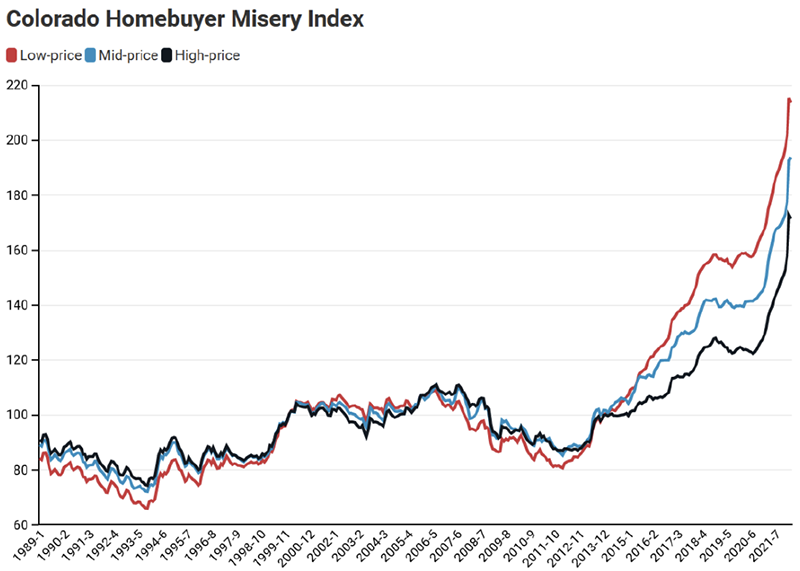
As the “Homebuyer Misery Index” rate increases, housing affordability decreases. It shows that affordability has decreased by 36.7%, 33.7% and 35% in the low, mid, and high tiers since June 2020.
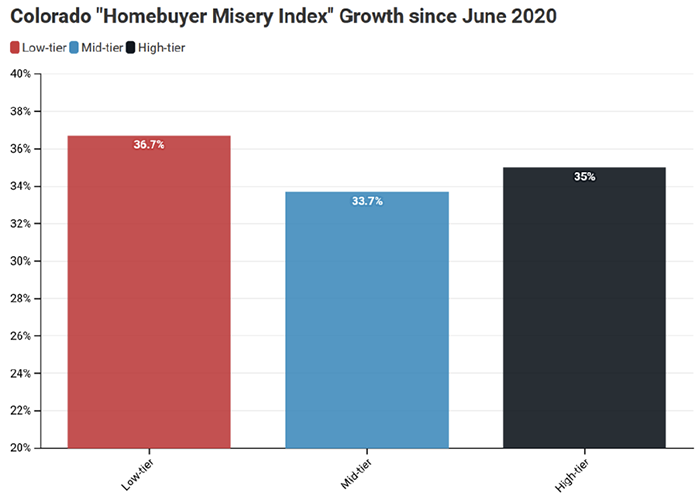
To put this in terms of a monthly expense, the U.S. Census Bureau reports that the median price of a home in Colorado in 2000 was $166,600. Financing this home with a 30-year mortgage (8.15%) with no down payment in 2000 would result in a mortgage payment of $1,240. To purchase a median-priced home in May 2022 would cost $600,000 (a 260% increase since 2000), and assuming it’s financed with the same 30-year mortgage (now 5.3%) and no down payment, it would result in a monthly mortgage payment of $3,332, a 169% increase.
In recognizing the urgency for more affordable housing and acknowledging the need to address “critical levels” of housing supply, the state legislature stated that population growth has placed “unsustainable demands on our limited housing stock”.[v] Due to continuing supply issues, policymakers should focus on policies that will incentivize and create more housing – such as the recently passed HB22-1282 which created an innovative housing incentive program. Yet as laudable as that program can be, the legislature also passed legislation that will make it harder, and more expensive, to build new housing units.
HB22-1362 Energy Code Adoption
During the 2022 legislative session, the General Assembly passed HB 22-1362 which was signed into law by the Governor on June 2, 2022. It requires the adoption of model code language that would achieve energy performance “equivalent [to] or better” than the 2021 International Energy Conservation Code (IECC). It also requires the development of an electric and solar ready code and a model green code by a newly established Energy Code Board convened by the Colorado Energy Office (CEO) and the Department of Local Affairs (DOLA).
The legislation goes further than earlier legislation passed in the 2019 session (HB 19-1260) which required local jurisdictions to adopt one of the three most recent versions of the IECC at a minimum, upon updating any other building codes[vi]. At that time, the most current IECC model energy code was the 2018 IECC which only changed slightly from prior versions going back to 2012 and did not dramatically alter standards from prior code iterations. The changes in the 2021 IECC represent a major change in energy efficiency requirements over the 2018 version. The U.S. Department of Energy determined that the 2021 IECC was 9% more efficient than the 2018 version. Thus, the passage of HB 22-1362 which requires codes “equivalent or better” energy performance than the 2021 IECC represents a larger energy efficiency hurdle for new buildings in the state.
With the passage of HB22-1362, the state departed from local home rule governance policies that characterize housing development in the state of Colorado. In doing so, they have acknowledged that energy conservation in the built environment supersedes local preferences and standards. In contrast to a uniform statewide building code which focuses on the safety and integrity of structures, the state has dedicated its policy priorities to energy conservation and stretch codes that will pave the way for full electrification of buildings.
Housing is a hyper local issue. In our 2021 fellowship report, “From Conflict to Compassion: A Colorado Housing Development Blueprint for Transformational Change” my co-fellow Peter LiFari and I discuss the importance of home rule but also that some aspects of housing are a statewide concern.[vii] Specifically, we recommended adoption of a statewide building code as part of a solution to address supply side deficiencies in the housing development continuum. Without a uniform statewide building code, which would allow standardization across jurisdictions, a statewide minimum energy code, as a subset of building codes, does not enable efficiencies or economies of scale. Builders would still need to adapt to each jurisdiction’s building code and then implement the energy code, losing the standardization feature which was the basis of our recommendation.
The homebuilding industry is one of the last major industries to be disrupted by new technology.[viii] The adoption of a uniform building code would unlock innovation by allowing markets for products that require consistency and standardization such as offsite or modular homes. Additionally, modular homes are more energy efficient than typical site-built homes. Factory constructed homes are designed as building blocks that fit together with tight tolerances resulting in better insulation. Tightly insulated walls, floors, windows, and ceilings keep air from leaking in or out. While energy efficient equipment is key, it is just one of the many factors that impact a building’s energy efficiency, air quality, durability, and comfort. Therefore, adoption of a uniform statewide building code would have had the dual advantage of opening the door to true productivity gains and creating more energy efficient homes.
On the other hand, the adoption of a minimum energy code across the state does not create the same efficiencies that uniform building code does. Homebuilders will continue to contend with different requirements across jurisdictions adding to the complexities and cost of projects. In addition to learning new energy code requirements, builders must learn how the energy code integrates with the building code of the local jurisdiction. HB22-1362 allows localities to adopt more stringent energy codes than the model code which exacerbates this issue further.
Therefore, the passage of HB22-1362 increases the complexity of building in Colorado which will add to the time and cost to build. Advocates of the stricter energy code stress the increased costs are offset by the benefits to health and the environment. Although given the choice in a real-world scenario we saw that consumers overwhelmingly chose to not make the tradeoff.
In the aftermath of the Marshall fire that destroyed over 1000 homes in the communities of Louisville and Superior at the end of 2021, these communities found local adoption of the 2021 IECC would add to the cost to rebuild every home and increase the time to rebuild. Before the fire, the Louisville City Council adopted the 2021 IECC with amendments and Appendix RC (Zero Energy Residential Building Provision) on October 19, 2021. Prior to the adoption, the city was utilizing 2018 IECC. The additional requirements include a combination of on-site solar with off-site solar, or alternatively, off-site solar through a Community Solar Garden (CSG) to offset the use of energy in their home.
After the fire destroyed 550 homes in Louisville on December 30, 2021, homeowners were faced with the prospect of rebuilding with the newly adopted codes and mandatory net zero requirements. There was no question that the new codes would add to the cost to rebuild homes to the current code, however, the magnitude of impact estimates varied depending on assumptions taken, as well as rebates and incentives offered by third parties.
Therefore, the Louisville City Council requested Group 14, a Colorado-based consulting firm with expertise in built environment projects, to prepare a cost analysis to understand the cost differential to build to both the 2018 and 2021 IECC for fire affected homes. Group 14 estimated the cost to upgrade to meet the different iterations of the 2021 IECC (with or without Appendix RC) would incur additional costs to homeowners anywhere from $6,450 - $22,352 per home[ix]. Most homeowners were underinsured anywhere from $100,000 to $500,000 and under the new building code they could not afford to rebuild.
The following table is adapted from Group 14’s report[x] and shows the additional cost of equipment for implementing 2021 IECC for an average home rebuild which were based on estimates from local homebuilders working in the local market. The average size of a home lost in Louisville was 2,820 square feet with 4 bedrooms and 3 bathrooms. Because Louisville adopted the additional net zero building code, those costs are listed as well. Xcel Energy, the regional utility, offered various rebates and incentives to Marshall Fire victims to implement 2021 IECC and considered other monetary incentives for compliance with Energy Star v3.2, Zero Energy Ready Home v2, Energy Star New Certification Program, and Passive House Standards[xi]. Because these rebates were uniform across all iterations but only available to Marshall Fire victims, those costs were not included below.
[table id=13 /]
Most homes destroyed in the Marshall Fire were built in the 1990s. Even building to the 2018 IECC, the code used previously, would mean newly built homes would be more energy efficient than their predecessors. Since 2015, the Department of Energy’s minimum standard of 80% Annual Fuel Utilization Efficiency rating (AFUE) had already been adopted or exceeded by many manufacturers. And new high efficiency gas furnaces that are Energy Star approved are 90 – 98% efficient (AFUE rating). No doubt some displaced homeowners would prefer to build to a higher standard than the 2021 IECC represents. The choice should be the homeowners to make based on their preference and budget and not forced upon them by government regulation.
The Louisville City Council agreed and approved an exemption for fire victims from the 2021 IECC and Appendix RC. Just days after, the state legislature moved forward in passing HB22-1362, albeit with amendments that included exemptions for disaster victims.
HB22-1362 Paves the Way for Full Beneficial Electrification
HB22-1362 created a requirement for a minimum statewide energy conservation standard but also required the development of stretch codes for electric and solar and net zero buildings. HB22-1362 is a major step toward full, beneficial electrification in the built environment. The model codes must include mandatory support for building electrification whether or not the homeowner wishes to use natural gas for heating and appliances, mandatory electric vehicle charging infrastructure regardless of what the homeowner drives, and mandatory solar panel capacity whether or not solar is desired or more cost effective.
Nationally, buildings currently represent 39% of global GHG emissions; 28% of that is operational, meaning the equipment inside of a building such as stoves and furnaces, and the remaining is embodied, meaning the byproduct of construction building materials. To meet the state’s aggressive GHG emission reduction targets, addressing the built environment is necessary. Because HB22-1362 applies to new builds, it will only impact a small percentage of buildings in the state. To reduce GHG emissions and meet state targets, millions of existing homes that currently utilize fossil fuels will need to be retrofitted. However, forcing electrification too quickly will be expensive to consumers.
The equipment needed for building electrification will become less expensive over time as technology improves and becomes more widely available. A 2020 study by Xcel Energy found that full electrification of new customers in Colorado would cost $7,000 per home but stated that the cost would drop significantly over the next few years.[xii] While the state’s desire to address GHG emissions in the built environment is strong, a moderate approach is needed to minimize unintended consequences of a forced transition on property owners.
Market barriers exist that hinder the retrofitting of existing homes to electrification due to cost and preference. While improvement in electrification technology increases reliability and cost effectiveness, and as electrification becomes more discussed, consumer preferences still have not changed much. Between 2013 and 2020, the use of gas for space heating has declined only slightly from 62% to 57% while gas preference has slightly increased for water heating, 68% to 69%, and cooking fuel, 51% to 52%[xiii].
As cities move forward with natural gas restrictions and bans, professional chefs were not pleased, showing a preference for natural gas for cooking both for commercial and residential uses.[xiv] With gas ranges temperature can be changed quickly and more incrementally than on a traditional electric stove. For electric induction ranges, the change in temperature has less of a lag, however, these models are more expensive than traditional electric or gas ranges and also require induction cookware which may require consumers to change out their cookware.
Natural gas has been the most effective and efficient choice for consumers for furnaces and water heaters, particularly in colder climates.[xv] Recent advancements in cold climate heat pump (CCHP) technology have achieved more reliable heating performance over other electric heat pumps. Previously heat pumps running on electricity lost efficiency and performance when outside temperatures sunk below freezing, making heat pumps a less than viable option for Colorado homes. However, there is still an educational gap as many installers are aware of the differences between a regular heat pump and a CCHP which will lead to regular heat pumps being installed in cold climates, according to a recent report by Guidepost.[xvi]
In addition to a change in equipment, electrification would require additional infrastructure, both in front of the meter and behind the meter while continuing to service natural gas customers. This would require the utility to continue to maintain gas delivery infrastructure while making large investments in the infrastructure required to meet increased demand for electricity. Xcel found that a voluntary adoption scenario would only add $15-23 per year to non-participating customers’ bills (as of 2030) in comparison to a $930 increase in the mandated scenario.
In September 2020, Black Hills Energy provided an estimate for the costs of electrification for customers within Rocky Ford, CO. Their analysis includes the infrastructure to provide the electricity to all housing units, appliance cost, and behind the meter costs which are costs to be covered by the customer individually. The analysis found that the total cost to electrify all 1,543 housing units in Rocky Ford would be $50.2B on average, $32,538 per housing unit. CSI extended the results of the Rocky Ford study to all 1,640,580 housing units in Colorado that are not using electricity as a heating and cooking fuel, the assumption being that the 472,807 housing units that use electricity as a heating and cooking fuel will not have to be retrofitted.
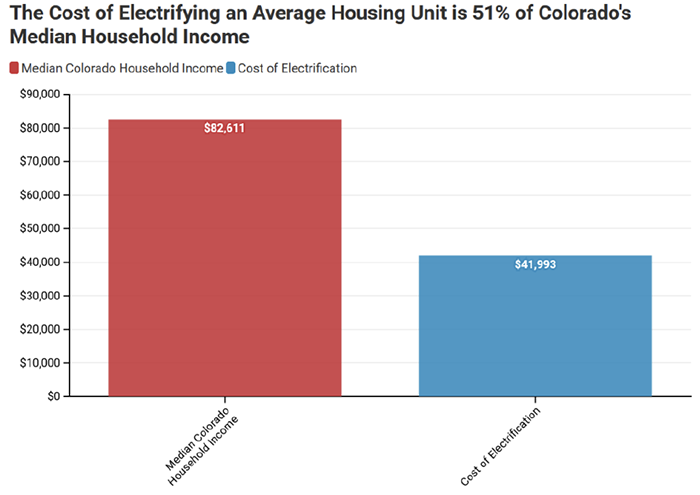
CSI then produced an estimate of retrofitting 74,300 commercial properties in the state. Estimates of the number of commercial properties come from state property tax records[xvii]. The cost of electrification per commercial unit comes from a study done by the Group 14 Engineering[xviii]. They show that the cost of electrification of a commercial building is $241,200 on average. This estimate does not consider the cost of providing additional infrastructure to deliver electricity to commercial buildings. To electrify all commercial buildings, we estimate it would cost $17.9B. The estimated combined cost to electrify all existing residential and commercial units in Colorado is $71.3B.
[table id=14 /]
Another study that looked at the cost of electrification across all 50 states estimated total (transportation, direct use infrastructure, household cost, commercial building cost, vehicle cost, off-road vehicles such as construction and farm equipment) electrification for Colorado to be closer to $488 billion which includes $15 billion in household cost and $134 billion in commercial building cost.[xix]
Amidst the widely varying estimates of the cost of electrification, policymakers need to acknowledge that the true cost is unknown. Additionally, as CSI has reported, Colorado’s electrical grid cannot handle a rapid increase in demand without causing consumer rates to increase dramatically[xx]. Care must be taken so risks associated with rapid electrification will ensure affordability to the consumer and reliability of the electric grid.
An overly aggressive transition to electrification will impact the reliability of the grid as well as increase prices for natural gas customers who will bear the brunt of maintaining the costs maintaining and safely operating natural gas infrastructure. These costs would fall on low-income households who could not afford to transition early on.
Energy Code Board Should Take a Measured Approach
To ensure the risks of rapid electrification are understood and mitigated, the process of the code development is important. HB22-1362 outlines the process for the state’s energy code adoption and establishes an Energy Code Board that is appointed and convened by the Colorado Energy Office (CEO) and the Department of Local Affairs (DOLA).
Membership of the board includes CEO Director, or the Director’s designee, who will appoint 10 additional members: one member representing urban counties of the state, one member representing the municipalities in rural areas of the state, two members representing environmental or sustainability groups, one solar power expert, one energy efficiency expert, one member representing professional engineers with building systems experience, one member representing electric utilities, a gas utility, or a combined electric and gas utility, one member representing architects, and one member who is a building energy code expert.
The DOLA Director, or the designee, will be on the board and appoint 9 additional members: one member representing rural counties of the state, one representing urban municipalities, two members representing affordable housing operations (one representing a for-rent nonprofit builder who serves populations with incomes under 80% AMI, and one representing a nonprofit affordable for sale housing builder), two members who hold and electrical license, plumbing license, or a professional credential in the mechanical trades (at least one of whom is a member of a labor organization), one member representing a statewide organization for home building professionals, one member with building operations expertise, and one contractor who provides mechanical, electrical, or plumbing services or represents a statewide association that represents mechanical, electrical, or plumbing contractors.
The process by which the Energy Code Board adopts model code is prescribed in the legislation. The legislation also provides for an Energy Code Executive Committee which can adopt a code should the Energy Code Board not reach consensus by a 2/3rds vote.
Utilizing a robust stakeholder process will ensure buy-in by the diverse actors involved in the housing development continuum. A robust board membership will ensure many interests will be represented. However, without a public comment process, the interests of the largest stakeholders, taxpayers, will not be represented. Additionally, with such diverse interests represented among the Board membership, consensus may not be reached which will leave the Executive Board, an inherently political committee, to adopt a code.
Therefore, to ensure a robust and transparent process, the Energy Code Board should allow for public input on code requirements and adopt a guiding principle that any new standards should be that changes are cost-effective and should be accompanied by an economic study of the impact on affordability. Cost-effective measures should be based on a simple payback method, i.e., a calculation of how long it would take for the homeowner to recoup upfront costs through utility bill cost savings, to the home buyer that does not exceed 10 years or use the social cost of carbon.
Conclusion
Across the United States, states and localities are weighing the benefits of electrification against the costs. Indeed, discerning whether electrification is indeed beneficial. Given the massive costs associated with electrification, the impacts on the electricity grid, and consumer preferences regarding natural gas, the choice is far from clear. Some states and cities have moved towards full electrification by banning natural gas appliances. Berkley, CA was the first U.S. city to require building electrification for new buildings beginning January 1, 2020. Washington recently became the first state in the country to mandate that newly constructed buildings use all electric space heating and hot water systems for commercial and multi-family buildings. This occurred almost simultaneously as a similar measure in New York that would ban fossil fuel heating in new buildings. This measure failed to pass in the state legislature during budget talks.
While HB22-1362 does not mandate electrification, it paves the way for building electrification through the development and adoption of model codes. These are important precursors to support electrification and electrification readiness. However, significant barriers exist to full electrification for Colorado’s commercial and residential buildings. Given the significant complexity of a statewide transition from fossil fuels to renewables, additional considerations as to the total cost of electrification must be taken before implementing electrification policies, particularly when any additional costly regulation adds to the already significant cost to build in Colorado.
An aggressive and complete transition from fossil fuels will be costly. To ensure costly policies do not overly burden housing development in Colorado, policymakers should ensure that widescale implementation of an electrification plan will be based on informed tradeoffs by:
- Ensuring a transparent and fair stakeholder process for adoption of energy and green codes that includes public comment and input;
- Adopting energy efficiency standards that also prioritize affordability;
- Undertaking a return-on-investment analysis of electrification with a payback period that does not exceed 10 years, over the average length of homeownership.
[i] https://drive.google.com/uc?export=download&id=1Klq9pdHjeGTFaol2VCabKnLJVB4Ksx0g
[ii] https://commonsenseinstituteco.org/co-housing-blueprint/
[iii] https://car-co.stats.showingtime.com/docs/mmi/x/Statewide?src=map
[iv] https://marketstatsreports.showingtime.com/CAR-Colorado_hqac0/sst/202204/0SF.htm
[v] https://leg.colorado.gov/sites/default/files/2022a_1282_signed.pdf
[vi] https://www.leg.colorado.gov/bills/hb19-1260
[vii] https://commonsenseinstituteco.org/co-housing-blueprint/
[viii] Ibid.
[ix] https://www.louisvilleco.gov/home/showdocument?id=34232&t=637814040411046672
[x] Ibid.
[xi] Ibid.
[xii] https://www.xcelenergy.com/staticfiles/xe-responsive/Environment/Carbon/Xcel Energy Transitioning Natural Gas for a Low-carbon Future, Nov 2020.pdf
[xiii] https://www.homeinnovation.com/trends_and_reports/trends/a_how_it_is_heated_debate_gas_or_electric_2021_update
[xiv] https://www.wsj.com/articles/cities-try-to-phase-out-gas-stovesbut-cooks-are-pushing-back-11626514200
[xv] https://www.eia.gov/todayinenergy/detail.php?id=30672
[xvi] https://guidehouseinsights.com/reports/Cold-Climate-Heat-Pumps
[xvii] State of Colorado Fiftieth Annual Report to the Governor and the General Assembly (2020).
[xviii] Electrification of Commercial and Residential Buildings: An Evaluation of the system options, economics, and strategies to achieve electrification of buildings. Group 14 Engineering, PBC, August 2020.
[xix] https://www.heartland.org/_template-assets/documents/publications/EELI-Tanton-Renewable-Electrification-cost-comparison.pdf
[xx] https://commonsenseinstituteco.org/understanding-costs-and-impacts-of-energy-performance-mandates-for-buildings/